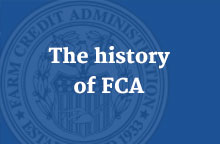Frequently Asked Questions
Click on a category below for FAQs on the respective topic. For frequently asked questions about YBS reporting, go to Frequently Asked Questions and Step-by-Step Instructions for Preparing the Young, Beginning, and Small Farmers and Ranchers Report (PDF).
General questions about FCA Risk identification Similar entity reporting Operating and strategic business planning for diversity and inclusion Flood insurance Borrower rights Collateral evaluations Disclosure and reporting rule Governance changes in 2006Operating and strategic business planning for diversity and inclusion
We have developed the following FAQs to answer the most common questions we receive from Farm Credit System institutions regarding the business planning rule. Since System institutions are the primary audience for these FAQs, we are treating the questions and answers as a dialog between us (FCA) and you (the System institutions).
These FAQs do not address all situations institutions may encounter nor all diversity and inclusion best practices. Over time, we may update these FAQs based on feedback we receive.
Note: These FAQs are based on the preamble that the FCA Board adopted to explain the business planning rule. We urge you to review the preamble, and the provisions of the rule that are referenced in these FAQs, for a complete understanding of the regulation. The preamble was published in the Federal Register at 77 FR 25577, on May 1, 2012.
General
1. What does "underserved" mean in the preamble and these FAQs?
We use "underserved" to refer to potential eligible and creditworthy borrowers who may not have previously had access to credit for various reasons. You need to market your products and services to all potential qualified borrowers in your territory, with specific outreach efforts toward diversity and inclusion within each existing and emerging market segment. You must also ensure that you do not have barriers that could inhibit your service to potential borrowers. For example, you should ensure:
- that your employees are trained to do business with a customer base that reflects the diversity of your territory,
- that your loan products meet the needs of all eligible and creditworthy persons in your territory, and
- that your underwriting standards are flexible enough to consider all creditworthy persons in your territory.
2. Is there a template we can use for incorporating diversity and inclusion strategies into a business plan?
No. A one-size-fits-all approach is not appropriate for effective business planning. Instead, you should complete business planning in any reasonable manner that demonstrates well-thought-out strategies and actions to strive for diversity and inclusion in employment and lending.
3. Are there any reporting requirements?
Yes. You must annually report to your board of directors the progress you have made in accomplishing planned outreach strategies and actions. [Section 618.8440(c)]
Human Capital Plan
4. What are the parameters for developing the human capital section of the business plan?
You should identify strategies and actions consistent with existing employment laws and rules. You should not gather or record data on applicant or employee characteristics not currently legally gathered or recorded. [Section 618.8440(b)(7)]
5. What should we consider when incorporating diversity and inclusion strategies into our human capital plan?
You should study and know your workforce and management succession plans, and you should strive to improve outreach efforts to qualified candidates across the labor market. Such outreach efforts should include recruitment channels that more effectively reach diverse labor force populations. [Section 618.8440(b)(7)]
6. Does the rule require us to establish quotas when we develop our human capital plan to improve diversity and inclusion in the workplace?
No. The rule does not require you to establish hiring quotas. You should not hire persons who are not the best qualified for the positions for which they are applying. In addition, the rule does not require specific outcomes in employment. However, it does require you to use effective strategies and actions to strive for diversity and inclusion within the workforce and management. [Section 618.8440(b)(7)(iii)]
7. Does the rule require us to collect demographic data from job applicants and employees?
No. The rule does not require you to collect data on job applicants or employee characteristics for the purpose of implementing human capital plan strategies. However, where employment laws require the collection of these data, you may use the data to assess the diversity of your workforce. [Section 618.8440(b)(7)(i)]
8. Should sensitive or confidential data supporting the human capital strategies and actions be included in the business plan?
You are not expected to include sensitive or confidential information pertaining to human capital planning in your business plan. Instead, you may summarize and incorporate by reference the supporting data, including sensitive and confidential information as long as the information is in other board-approved documents that are adopted annually. Any public disclosure of business plans does not require the inclusion of confidential or sensitive information. [Section 618.8440(b)(7)]
9. What would FCA consider to be a good faith effort by an institution to improve workplace diversity and inclusion?
We consider good faith efforts to be strategies and actions that may not always produce the desired results but that over time lead to tangible improvements in workplace diversity and inclusion. As management reports to its board on its progress in accomplishing the strategies and actions in your institution's plan, the board should establish accountability and formulate new strategies and actions if necessary. [Section 618.8440(b)(7)(iii)]
10. Where can we find guidance on labor market studies?
If you have more than 20 employees, you already have some labor market information in your affirmative action program plan analysis. This analysis, which provides information about your inclusion of women and minorities in your workforce, offers a sound foundation for a comprehensive human capital plan. In addition, you may want to use available statistics to derive information about your labor market. Examples of such statistics include census data, data from local job service offices, and data from colleges or other training institutions. Other sources may be available at the Federal, State or local level or through third-party research services. You are not required to use these statistics, but you may find them helpful. [Farm Credit Act, Section 4.38]
Marketing plan
11. What are the parameters for developing the marketing plan section of the business plan?
You should identify strategies and actions consistent with existing lending laws and rules, as well as safety and soundness standards. You should not gather or record data on applicant or customer characteristics not currently legally gathered or recorded. [Section 618.8440(b)(8)]
12. What should we consider when incorporating diversity and inclusion strategies into our marketing plans?
You should study and know your customer base and agricultural marketplace. You should identify opportunities to reach out to potential eligible and creditworthy customers who may not have previously had access to credit for various reasons. You should have specific outreach toward diversity and inclusion within each market segment. [Section 618.8440(b)(8)]
13. Does the rule require us to establish quotas in developing the marketing plan to improve diversity and inclusion in lending?
No, the rule does not require you to establish lending quotas. In addition, the rule does not require specific outcomes in lending. You should not extend credit to any persons who are not eligible, creditworthy, or within the scope of financing rules. However, the rule does require effective strategies and actions to market to all eligible and creditworthy persons, with specific outreach toward diversity and inclusion within each market segment. [Section 618.8440(b)(8)(ii)]
14. Does the rule require us to collect demographic data from loan applicants and customers?
The rule does not require you to collect any data on loan applicants or customers for purposes of implementing the marketing plan strategies. However, where lending laws require the collection of this type of data, you may use the collected data to evaluate your lending results. [Section 618.8440(b)(8)]
15. Should sensitive or confidential data supporting the marketing plan strategies be included in the business plan?
You are not expected to include sensitive or confidential information pertaining to market planning in the business plan. Instead, you may summarize and incorporate by reference the supporting data, including sensitive and confidential information, as long as the information is in other board-approved documents that are adopted annually. You are not required to include confidential or sensitive information in any public disclosure of your business plan. [Section 618.8440(b)(8)]
16. Are there sources of information that we must use to analyze and understand our potential lending markets?
No. You should do enough research to gain an understanding of potentially underserved or emerging market segments. A combination of quantitative and qualitative data and analysis will help you better understand your chartered territory. You can obtain useful information through outreach efforts to various groups or organizations. With this knowledge, you can determine whether there may be potential eligible borrowers you can reach through better marketing and outreach methods. Then, you can reach out to these markets regarding the System's programs and services. Also, you will be better equipped to develop marketing strategies and actions that appropriately address diversity and inclusion. [Section 618.8440(b)(8)(i)(ii)]
17. What sources of information are available to help us understand our potential markets?
There are many potential resources you can use to make a good faith effort to describe your chartered territory by market segment. A vast amount of demographic information, down to the county level, is available on websites. In conducting market surveys, you can also use resources such as the following:
-
System Diversity Workgroup
-
Farm Credit Council
-
Other System institutions
-
Census of Agriculture
-
U.S. Census Bureau
-
U.S. Department of Agriculture's Economic Research Service
-
State agriculture departments
-
Affinity agricultural groups
-
Land-grant colleges and universities
-
Chambers of Commerce
Other sources may be available at the Federal, State, or local level or through third-party research services. You are not required to use these resources, but you may find them helpful. [Section 618.8440(b)(8)(i)]
18. How detailed do strategies and actions need to be in the marketing plan?
The strategies and actions should demonstrate that you understand your territory well enough to achieve diversity and inclusion when providing services to all potential clientele in your territory. To serve some markets, your strategy may need to be more detailed than for other markets. For example, language or cultural barriers may exist in some markets, so your strategy should address these particular market segment barriers. If there are underserved or emerging segments, such as local foods, you may need to design new methods or approaches for these market segments rather than relying on a more general strategy. [Section 618.8440(b)(8)(ii), Bookletters 066 and 040]
19. What is considered a good faith effort in marketing to emerging or underserved markets?
You should reach out to all potential eligible and creditworthy borrowers, including those who may not have previously had access to credit for various reasons. To reach diverse, emerging, and underserved populations in your territory, you may want to consider using grassroots outreach and education regarding business and financial planning, leadership, and loan programs for persons who are eligible and creditworthy. Traditional marketing efforts and lending models may not fit producers in underserved or emerging markets; you should ensure you consider activities to reach out to all potential qualified borrowers in these markets. [Section 618.8440(b)(8)(ii)]
20. Will lending to young, beginning, and small farmers in emerging or underserved markets create safety and soundness concerns?
New entrants into agriculture may have difficulty meeting underwriting standards because of limited capital and collateral positions. However, they may still be creditworthy because many generate sufficient off-farm income to repay their debt. Other compensating factors or credit enhancements may also be available. You should consider whether the risks in such lending are warranted by taking into account your risk-bearing capacity, as well as the System's mission as a Government-sponsored enterprise to serve all types of eligible, creditworthy farmers and ranchers. We expect risk in these loans to lessen over time, but program risk should always remain within an institution's risk-bearing capacity. [Bookletters 066 and 040]
21. Can a strategy to enhance outreach to emerging or underserved markets include collaboration with other groups?
Yes, there are a variety of creative means to market to emerging or underserved groups, ranging from partnerships with charitable organizations serving agriculture to State or Federal partnerships. [Section 618.8440(b)(8)(ii)]
Board diversity
22. What strategies should we consider to improve diversity on our board?
While the majority of your board members are elected by stockholders, you have several ways to make a good faith effort to diversify your board using elected, appointed, or outside director positions. For example, if your board determines, based on its self-assessment, that it needs to increase its diversity, it may do so through its authority to appoint directors (outside or stockholder directors). In addition, the nominating committee can advance diversity when fulfilling its duty to "endeavor to ensure representation from all areas of [an institution's territory] and as nearly as possible, all types of agriculture practiced within the territory." [Sections 618.8440(b)(2)(ii) and 611.325(d)(1), Bookletters 009 and 043]



